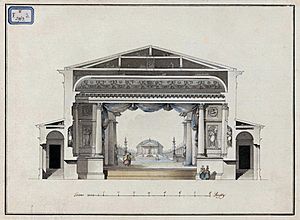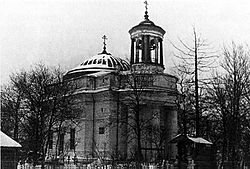Giacomo Quarenghi facts for kids
Giacomo Quarenghi (born September 20 or 21, 1744 – died March 2, 1817) was an Italian architect. He became very famous for his Neoclassical buildings in Imperial Russia, especially in Saint Petersburg. He created a grand and original style, inspired by the architect Andrea Palladio. Many other architects in Russia and Finland looked up to his work.
Some people have called him "the last of the great architects of Italy."
Contents
Giacomo's Early Life and Training in Italy
Giacomo Quarenghi was born in Rota d'Imagna, a town near Bergamo, Italy. His family was noble, and they wanted him to become a lawyer or a church official. However, Giacomo was allowed to study painting first. He learned from G. Reggi, who was a student of the famous painter Giambattista Tiepolo.
Young Giacomo was very smart and read a lot of books. He traveled around Italy, visiting cities like Vicenza, Verona, Mantua, and Venice. He spent the most time in these places. He even drew pictures of ancient Greek temples at Paestum. In 1763, he arrived in Rome, where a new art style called Neoclassicism was becoming popular.
He studied painting with Anton Raphael Mengs and then with Stefano Pozzi. Later, from 1767 to 1769, he switched to studying architecture. His first architecture teacher, Paolo Posi, taught a more traditional, older style.
Then, Giacomo found a copy of a famous book by Andrea Palladio called Quattro Libri d'archittetura. He wrote to his friend, "You could never believe the impression that this book made." He realized he had been taught incorrectly before. He then sought new teachers, Antoine Decrezet and Niccola Giansimoni, who taught the new Neoclassical style. He spent time measuring and drawing ancient Roman buildings.
While in Venice (1771–1772), studying Palladio's works, Quarenghi met a British lord. This connection helped him get some small jobs in England, like designing garden buildings and fireplaces. He also designed an altar for a private church in New Wardour Castle. His first big project (1771–1777) was to redesign the inside of the Santa Scholastica monastery in Subiaco. He also designed decorations for a Music Room in the Campidoglio for a cardinal.
His work in Italy and for English clients made him well-known. In 1779, Catherine II of Russia asked for two Italian architects to work for her. Quarenghi, who was 35, felt he didn't have enough work in Italy. So, he quickly accepted the offer and moved to St. Petersburg with his pregnant wife.
Working for Catherine the Great

Quarenghi's first major project in Russia was the English Palace in Peterhof. It was a grand rectangular building with a Corinthian style entrance. Empress Catherine loved it very much. Sadly, this building was destroyed during World War II and later taken down by the Soviet government. In 1783, Quarenghi and his family moved to Tsarskoe Selo. There, he oversaw the building of the Alexander Palace, which was his biggest project at that time.
As Catherine II's official court architect, Quarenghi designed many buildings for the Empress, her family, and her friends. He designed houses, summer homes, bridges, theaters, hospitals, a market, and a bank. He also created interior designs and garden plans. Some of his projects were built far from the capital, like a cathedral in Novhorod-Siverskyi, Ukraine.
In Moscow, he helped redesign the old Red Square in the new Palladian style. Count Nicholas Sheremetev hired him to design a theater hall in the Ostankino Palace. Quarenghi also designed a curved walkway for the Sheremetev Hospital. Many of his Moscow designs were later changed and built by other architects. This includes the Gostiny Dvor (1789–1805) and the Catherine Palace (1782–1787).
Working for Paul and Alexander I

Emperor Paul did not like many things his mother, Catherine, liked. This included Quarenghi's style of architecture. After the emperor became the protector of the Maltese knights, Quarenghi also joined the Order. He worked as their official architect until 1800. His projects became less frequent. The simple, balanced look of his buildings seemed less exciting to some people.
Because of this, he visited Italy in 1801 and received a warm welcome. He started focusing on watercolour paintings. He added scenes of daily city life to his architectural drawings. He also published several books of his designs (1787, 1791, 1810). He created detailed designs for decorative vases, column tops, and metalwork for royal homes, especially the Winter Palace.
When Alexander I of Russia became emperor, Quarenghi's work became popular again. In 1805, he became a member of the Imperial Academy of Arts. However, his design for the Anichkov Palace Colonnade received some criticism. People thought he used the old classical orders incorrectly. Quarenghi defended himself, saying that "good sense and judgment shouldn't be enslaved by commonly accepted rules."
Giacomo Quarenghi was given Russian nobility and a high honor, the Order of St. Vladimir, in 1814. After 1808, he mostly retired as a famous person. He had thirteen children with two wives. Some of his children stayed in Russia, while others went back to Italy. He passed away in Saint Petersburg at the age of 72.
In 1967, on the 150th anniversary of his death, Quarenghi's remains were moved. They were reburied at the Lazarevskoe Cemetery. A statue of him was also put up in Saint Petersburg.
Famous Buildings in St. Petersburg
Here are some of Giacomo Quarenghi's notable works in St. Petersburg:
- 1782–1783 – The Collegium of Foreign Affairs on the English Embankment.
- 1782–1787 – St. Mary's Hospital in Pavlovsk.
- 1783–1784 – The Bezborodko Country House in Polyustrovo.
- 1783–1787 – The Hermitage Theatre. This is the only 18th-century theater still standing in St. Petersburg. It was inspired by Andrea Palladio's Teatro Olimpico in Vicenza. Drawings of this theater were published in 1787, making Quarenghi famous across Europe.
- 1783–1789 – The Academy of Sciences on the University Embankment.
- 1783–1789 – The Russian Assignation Bank on Sadovaya Street.
- 1784–1787 – The Silver Rows on Nevsky Prospekt.
- 1786 – A wrought-iron bridge in Tsarskoye Selo.
- 1787–1792 – The Raphael Loggia in the Winter Palace.
- 1789–1796 – The Main Apothecary on Millionaya Street.
- 1784–1786 – The Saltykov house on the Field of Mars.
- 1788–1790 – The Vietinghoff house on Admiralty Prospect.
- 1790 – The Yusupov house on Sadovaya Street.
- 1791 – The bell tower of the Vladimirskaya Church.
- 1792–1796 – The Alexander Palace. This was designed for St. Petersburg but built in the Alexander Park of Tsarskoye Selo. He also designed pavilions in the Catherine Park, like the Concert Hall (1782–1788), the Kitchen Ruins (1780s), and the Hall on the Island (1794).
- 1797–1800 – The Maltese Chapel at the Vorontsov Palace.
- 1803–1805 – St. Mary's Hospital for the Poor on Liteiny Prospect.
- 1804–1807 – The Catherine Institute on the Fontanka Embankment.
- 1803–1809 – The Imperial Cabinet of the Anichkov Palace on Nevsky Prospect.
- 1806–1808 – The Smolny Institute for Noble Maidens.
- 1804–1807 – The Cavalry Manege, or Riding Academy on St Isaac's Square.
- 1814 – The Narva Triumphal Gate, which was later replaced by a permanent structure.
- 1814–1816 – The Anglican Church on the English Embankment.
See also
 In Spanish: Giacomo Quarenghi para niños
In Spanish: Giacomo Quarenghi para niños





